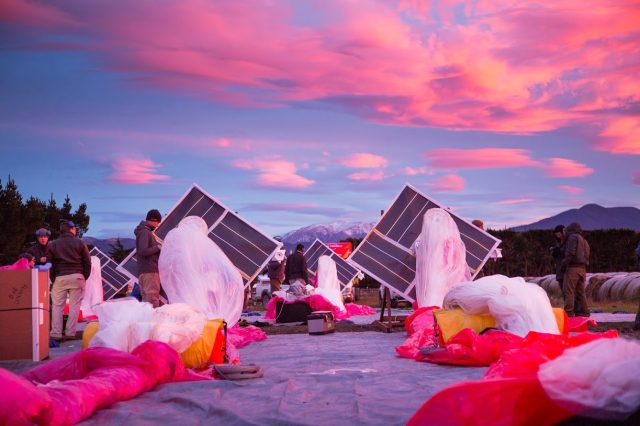Google balloons, “cell towers in the sky,” can serve 4G to a whole state
A single Project Loon balloon can cover an area the size of Rhode Island.

Google’s plan to deliver Internet service from balloons in the stratosphere has come a long way since being unveiled in June 2013.
A single “Project Loon” balloon can now remain in the air for more than six months and provide 4G LTE cellular service to an area the size of Rhode Island, according to Google. Company officials have taken to calling Loon balloons “cell towers in the sky.”
While there’s no announced date for a widespread service launch, Google has provided Internet to a school in Brazil and is partnering with cellular operators Vodafone New Zealand, Telstra in Australia, and Telefónica in Latin America.
The US probably won’t be the first place Loon powers a commercial service. Google is aiming to get more people in developing countries on the Internet (and that’s good for Google’s business, since a lot of those people will use Google services).
“For some countries, having Internet once a day for an hour is a huge deal,” Google software engineer Johan Mathe, who plays a key role designing Loon’s navigation system, told Ars in a phone interview last week.
Rather than offer Internet service itself as it does with Google Fiber, Google’s Project Loon is building technology that can integrate with the networks run by cellular operators. Telco operators can send signals from existing cell towers to Google’s balloons, and then the balloons send the signals down to smartphones and other cellular-connected devices. While Google says one balloon can cover an area the size of Rhode Island, the coverage area is really bigger than that because one balloon can send its signal to another balloon, which can then send Internet signals down to the ground. (A single balloon can cover an 80 km [49.7 miles] diameter. Rhode Island is 77 km [47.8 miles] north to south and 59.5 km [37 miles] east to west.)
“The main cost gain comes from the fact that you can cover a much bigger region with existing infrastructure,” Google told Ars. “Telcos take their preexisting infrastructure, point them to the sky, and they get a much broader coverage. For instance, if you already have towers to cover a city, you can point part of it to the sky, and you will be able to cover the whole region through the loon balloon network.”
The Loon devices are two balloons in one, an outer balloon filled with helium and a smaller one inside filled with air. “We can either pump air in it, which is going to make the balloon go down, or we can remove the air, which is going to make it go up. That's how we change altitude,” Mathe explained.
Each balloon has a radio for sending and receiving signals and can send its GPS position to the ground so that Google’s mission control software can track it in real time.
Google has boosted the balloons’ potential altitude range from about 800 meters to a couple of kilometers, allowing more control over where they fly. Early on, Google could keep the balloons in the air for about five days. Now the average is more than 100 days, with a record of 187. A Google announcement this month gives a sense of how that flight was achieved:
187 days is more than enough for Google’s purposes. In fact, the three-plus month average is enough because the company wants to be able to frequently upgrade the technology on the balloons, Mathe explained.
The shift from home Internet to cellular
When Loon started, Google was testing a system that delivered Internet service to antennas on people’s homes. Mathe explained that this was due at least partly to technology limitations. Project Loon is now capable of sending signals that can be picked up by the smaller antennas on phones.
“Because the power in a handset is smaller, you actually have to send more energy to send a data stream to a handset with a low antenna power than a… slightly more powered antenna you could have in a home,” he said.
There’s also a practical reason for focusing on cellular connectivity. “We see trends in developing countries where people are skipping laptops altogether and going straight to mobile,” Google spokesperson Katelin Jabbari told Ars.
Loon began with 3G-like speeds and is now using LTE, hitting about 10Mbps downloads. Real people have used Loon, but at small scales. “We've been doing extremely small experiments so far, one in Brazil where we gave Internet to a group providing Internet to a small school,” Mathe said.
Loon could help carriers reach villages with tiny populations where it wouldn’t be economically feasible to build cell towers, Jabbari said. Google is negotiating with telecommunications partners to expand the tests into bigger pilot projects within the next year, with the goal of eventually starting commercial operations.
Google has also been doing short duration tests in California to evaluate connection technology and designs, but the long flights have been outside the US.
“Right now we are launching primarily from New Zealand,” Jabbari said. “We chose that latitude initially because there are good winds and New Zealand is really excited to have us. The countries we're flying over were happy to give us overflight permission. Now we've gotten overflight permissions from all countries in the Southern Hemisphere.”
As for where pilot projects will begin, Jabbari said, “given that we have an established launch site in New Zealand and an established recovery zone in Latin America and other places, that's where you're most likely to see us, somewhere around there.” However, “we've had conversations with countries elsewhere and telcos elsewhere, those have all gone really well.” Jabbari said Google wants to create a “ring around the world” with its balloons.
What the service eventually looks like depends a lot on telecommunications providers.
“We’re actively looking for various partners everywhere to grow our potential,” Mathe said. “It really depends on partners and the kinds of things they want to provide to their customers and the kind of network access they want to provide.”


No comments:
Post a Comment